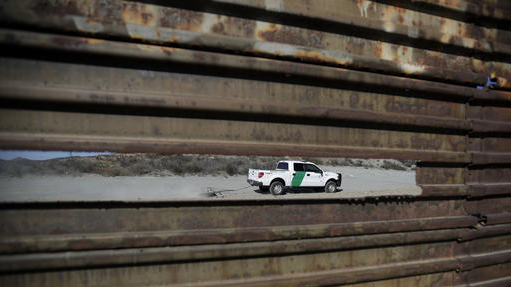WASHINGTON — President Donald Trump moved aggressively to tighten the nation’s immigration controls Wednesday, signing executive actions to jumpstart construction of his promised U.S.-Mexico border wall and cut federal grants for immigrant-protecting “sanctuary cities.” As early as Thursday, he is expected to pause the flow of all refugees to the U.S. and indefinitely bar those fleeing war-torn Syria.
“Beginning today the United States of America gets back control of its borders,” Trump declared during a visit to the Department of Homeland Security. “We are going to save lives on both sides of the border.”
The actions, less than a week into Trump’s presidency, fulfilled pledges that animated his candidacy and represented a dramatic redirection of U.S. immigration policy. They were cheered by Republicans allies in Congress, condemned by immigration advocates and the trigger for immediate new tension with the Mexican government.
Trump is expected to wield his executive power again later this week with the directive to dam the refugee flow into the U.S. for at least four months, in addition to the open-ended pause on Syrian arrivals.
The president’s upcoming order is also expected to suspend issuing visas for people from several predominantly Muslim countries — Iran, Iraq, Libya, Somalia, Sudan, Syria and Yemen — for at least 30 days, according to a draft executive order obtained by The Associated Press.
Trump is unveiling his immigration plans at a time when detentions at the nation’s southern border are down significantly from levels seen in the late 1990s and early 2000s. The arrest tally last year was the fifth-lowest since 1972. Deportations of people living in the U.S. illegally also increased under President Barack Obama, though Republicans criticized him for setting prosecution guidelines that spared some groups from the threat of deportation, including those brought to the U.S. illegally as children.
As a candidate, Trump tapped into the immigration concerns of some Americans who worry both about a loss of economic opportunities and the threat of criminals and terrorists entering the country. His call for a border wall was among his most popular proposals with supporters, who often broke out in chants of “build that wall” during rallies.
Immigration advocates and others assailed the new president’s actions. Omar Jadwat, director of the American Civil Liberties Union’s Immigrants’ Rights Project, said the president’s desire to construct a border wall was “driven by racial and ethnic bias that disgraces America’s proud tradition of protecting vulnerable migrants.”
How Trump plans to pay for the wall project is murky. While he has repeatedly promised that Mexico will foot the bill, U.S. taxpayers are expected to cover the initial costs and the new administration has said nothing about how it might compel Mexico to reimburse the money.
In an interview with ABC News earlier Wednesday, Trump said, “There will be a payment; it will be in a form, perhaps a complicated form.”
Mexican President Enrique Pena Nieto, who has insisted his country will not pay for a wall, has been expected to meet with Trump at the White House next week, although a senior official said Trump’s announcement had led him to reconsider the visit.
Congressional aides say there is about $100 million of unspent appropriations in the Department of Homeland Security account for border security, fencing and infrastructure. That would allow planning efforts to get started, but far more money would have to be appropriated for construction to begin.
Trump has insisted many times the border structure will be a wall. The order he signed referred to “a contiguous, physical wall or other similarly secure, contiguous and impassable physical barrier.”
To build the wall, the president is relying on a 2006 law that authorized several hundred miles of fencing along the 2,000-mile frontier. That bill led to the construction of about 700 miles of various kinds of fencing designed to block both vehicles and pedestrians.
The president’s orders also call for hiring 5,000 additional border patrol agents and 10,000 more immigration officers, though the increases are subject to the approval of congressional funding. He also moved to end what Republicans have labeled a catch-and-release system at the border. Currently, some immigrants caught crossing the border illegally are released and given notices to report back to immigration officials at a later date.
Trump’s crackdown on sanctuary cities — locales that don’t cooperate with immigration authorities — could cost individual jurisdictions millions of dollars. But the administration may face legal challenges, given that some federal courts have found that cities or counties cannot hold immigrants beyond their jail terms or deny them bond based only a request from immigration authorities.
Some of the nation’s largest metropolitan areas — including New York, Los Angeles and Chicago — are considered sanctuary cities.
The president also moved to restart the “Secure Communities” program, which was launched under President George W. Bush and initially touted as a way for immigration authorities to quickly and easily identify people in the country illegally who had been arrested by local authorities.
The program helped the Obama administration deport a record high of more than 409,000 immigrants in 2012. But Obama eventually abandoned the program after immigration advocates and civil libertarians decried it as too often targeting immigrants charged with low-level crimes, including traffic violations.
Among those in the audience for Trump’s remarks at DHS were the families of people killed by people in the U.S. illegally. After reading the names of those killed, Trump said, “Your children will not have lost their lives for no reason.”
Trump’s actions on halting all refugees could be announced as soon as Thursday. Administration officials and others briefed on the plans cautioned that some details of the measures could still be changed, but indicated that Trump planned to follow through on his campaign promises to limit access to the U.S. for people coming from countries with terrorism ties.

